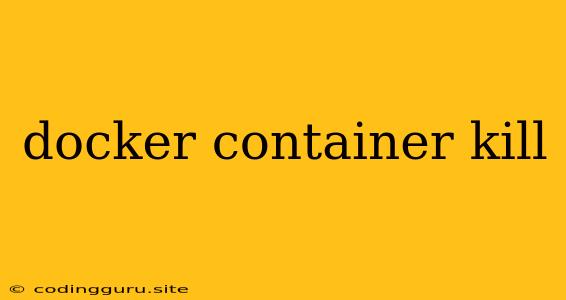Understanding and Utilizing the docker container kill Command
Docker, a widely used containerization platform, provides powerful tools for managing and interacting with containers. Among these tools is the docker container kill command, which plays a crucial role in graceful termination of running containers. This article delves into the intricacies of docker container kill command, exploring its functionalities, benefits, and practical applications.
Why Use docker container kill?
Containers, by nature, are designed for efficient resource utilization and isolation. However, situations may arise where you need to terminate a running container. Why might you need to kill a container?
- Resource Management: A container consuming excessive resources can impact system performance.
docker container killallows you to free up these resources by shutting down the container. - Testing & Debugging: During development, you may need to stop and restart containers to test new code or troubleshoot issues.
- Container Lifecycle Management: Sometimes, containers are intentionally designed to run for a specific duration. The
docker container killcommand can be used to terminate such containers when their lifecycle ends. - Security: If a container exhibits suspicious behavior or becomes compromised, immediately killing it can mitigate potential security risks.
Using docker container kill Effectively
The docker container kill command offers a straightforward way to terminate containers. Here's a breakdown of its usage:
Syntax:
docker container kill [OPTIONS] CONTAINER [CONTAINER...]
Essential Options:
-s SIGNAL: Specifies the signal to send to the container. The default signal isSIGKILL(forceful termination).-t TIMEOUT: Sets a timeout in seconds for the container to gracefully shut down.
Common Examples:
-
Forceful Termination:
docker container kill my-container -
Graceful Shutdown with Timeout:
docker container kill -t 10 my-container -
Sending a Specific Signal:
docker container kill -s SIGTERM my-container
Understanding Signal Types:
SIGKILL: Forcefully terminates the container without allowing for proper cleanup.SIGTERM: Sends a termination signal, allowing the container process to gracefully exit. This gives the container time to save data, clean up resources, and exit cleanly.
Choosing the Right Approach
The choice between forceful termination (SIGKILL) and graceful shutdown (SIGTERM) depends on your specific needs:
- Forceful Termination (SIGKILL): Use this when immediate termination is required. This method may result in data loss if the container is not able to save data before being terminated.
- Graceful Shutdown (SIGTERM): Use this whenever possible to ensure a clean shutdown and minimize the risk of data loss. It's the preferred method for most scenarios.
docker container kill vs. docker stop
You might be wondering about the difference between docker container kill and docker stop. Both commands stop a running container. However, the key distinction lies in the signal used:
docker stop: Sends theSIGTERMsignal to the container, giving it a chance to gracefully exit.docker container kill: Allows you to specify a signal, with the default beingSIGKILLfor forceful termination.
Best Practices:
- Utilize Graceful Shutdown: Opt for
SIGTERMwhenever possible to avoid data loss. - Define Timeout: Set a reasonable timeout period for graceful shutdown to prevent unnecessary delays.
- Monitor Container Health: If a container is repeatedly failing, investigate the underlying cause instead of repeatedly killing it.
Conclusion:
The docker container kill command is a vital tool for managing container lifecycle within Docker. Understanding its functionality, options, and proper usage can significantly contribute to efficient container management and minimize potential issues. Remember to choose the appropriate approach based on your specific needs and prioritize graceful shutdown whenever possible to ensure a clean and controlled termination of your containers.
